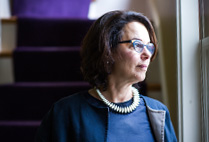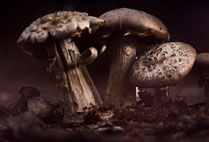Casey Sherman’s path to Hollywood started with a murder five years before he was born.
Mary Sullivan was just 19 when she was strangled in her apartment at 44-A Charles Street in Boston on January 4, 1964, the last of 13 victims attributed to the Boston Strangler. Sullivan’s sister Diane, then 17, is Sherman’s mother, and the murder’s toll on her family would drive her son to investigate the controversial case, starting with college journalism classes.
“My aunt was the reason I went to BU,” says Sherman (COM’93).
One of his first assignments at the College of Communication was a five-minute investigative report on the case. He went on to a career as a producer for WBZ-TV and an author who focuses on true crime. His first book, published in 2003, is the story of his aunt’s murder, A Rose for Mary: The Hunt for the Real Boston Strangler, which questioned the guilt of prime suspect Albert DeSalvo. Eventually, Sherman’s focus on justice expanded to include an appreciation for real-life heroes. His fifth book, 2009’s The Finest Hours, cowritten with Michael J. Tougias, describes a courageous Coast Guard rescue off Cape Cod in 1952. A film version, starring Chris Pine and Casey Affleck, was released in January 2016.
That film was only the first Sherman had a hand in last year. Patriots Day, starring Mark Wahlberg and based in part on Sherman’s eighth book, Boston Strong: A City’s Triumph over Tragedy, opened in December. The book, written with Dave Wedge and published in 2015, chronicles the Boston Marathon bombings and follows the survivors as they grapple with severe physical and emotional injuries for months, and years, afterward. (A planned Boston Strong production was combined with another film on the same topic to avoid splitting the audience, a common Hollywood practice.)
Sherman was a few blocks from the Marathon finish line when the bombs exploded on Boylston Street on April 15, 2013. He didn’t face the carnage that took lives, limbs, and peace of mind, but like many people in Boston, he was gripped by the week’s events. Friends immediately suggested that his next book should be about the bombings. He had no interest in the project, he says, until he heard about the survivors, the first responders, and others at the scene and realized here was a story “about the goodness of people as opposed to the terror we’re watching on-screen.”
Wedge, who’d met Sherman when he wrote a Boston Herald story on A Rose for Mary, covered the bombings for the Herald. The two friends committed to collaborating on a book “that would tell the story as fully as we could, and not just what happened in those five days,” Sherman says. “We wanted to embed ourselves with those survivors and see what their life was like every day.”
Spending hours with the family of murdered MIT Police officer Sean Collier was an experience Sherman says he’ll never forget. “We went in there not asking questions about Sean Collier the police officer. I was more interested in Sean the brother, Sean the son. What music did Sean listen to? Sean was a little brother—was he a pain in the ass? Was he fun?”
Boston Strong made the Boston Globe’s local best-seller list and topped Amazon’s true crime category.
More Than a Statistic
“I never knew my aunt Mary, but I knew the hold her death had on my family,” says Sherman, over a lunchtime beer at a pub near his South Shore home. “I heard whispers about it when I was growing up, but I never felt comfortable asking about it.”
As a teenager in the 1980s, Sherman watched the Tony Curtis movie The Boston Strangler on TV. “The next day, I said, ‘Mom, tell me about Mary,’ and she said, ‘Casey, Mary wasn’t just a statistic. She was my sister and my best friend.’
“I said, ‘Mom, at least they got the guy.’ And she looked up at me and said, ‘I don’t think they did.’”
DeSalvo had confessed to the Strangler murders, but was never tried; imprisoned for other crimes, he was stabbed to death in the maximum security prison MCI-Walpole in 1973. Inconsistencies in the investigation led many to suspect that DeSalvo was not the killer. In 2001, a team of forensic scientists exhumed Mary Sullivan’s remains and discovered what they believed was the killer’s DNA on her body. That DNA evidence did not match DeSalvo.
A Rose for Mary recounts the adult Sherman’s investigation of the case, focusing on problems with the evidence and pointing the finger at another suspect. But in 2013, new DNA testing established a near-certain match between DeSalvo and seminal fluid from the crime scene. DeSalvo’s exact role in Sullivan’s murder has never been determined. By then Sherman had written both novels and true-crime books and had sold Finest Hours to the movies.
Sherman has a few other projects in the works, including what he calls a CNN “true-crime travel show”—he recently shot a pilot for the show in Boston. He and Wedge have also started a production company for various TV and movie projects. But Sherman’s literary efforts remain the focus. The two men are working with local resident Pete Frates and his family on Challenge, a book about Frates’ battle with ALS and their creation of the Ice Bucket Challenge, which raised millions for the charity. And Sherman and Tougias are writing Above and Beyond, focused on two U-2 pilots caught up in the Cuban Missile Crisis. Sherman expects both books to come out later this year and hopes to develop both into films.
“I think we’ve got an entire generation that believes heroes only exist in Marvel comic books and Avengers movies, when in fact there are real heroes around us every day,” Sherman says. “Whether it’s 1952 and a small lifeboat off the coast of Cape Cod or 2013 on Boylston Street, you have ordinary people jumping into the fray, for the mission of saving somebody’s life. That, to me, is a story worth telling.”













































Related Stories
COM Screens New Benghazi Film 13 Hours
Michael Bay’s thriller based on book by COM’s Zuckoff
LGBTQ Heroes, from Lincoln to Mr. Sulu
Alum’s book Queer, There, and Everywhere looks at 23 cultural icons
BU Costars alongside Eddie Murphy in New Film
Campus featured prominently in drama Mr. Church
Post Your Comment